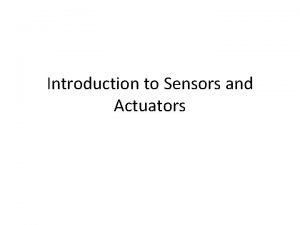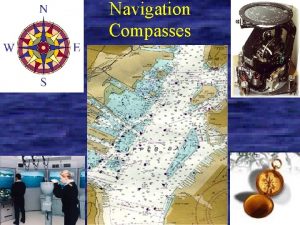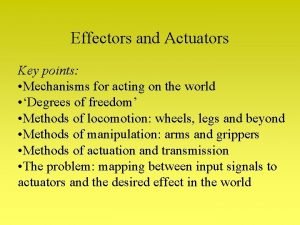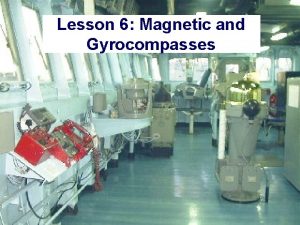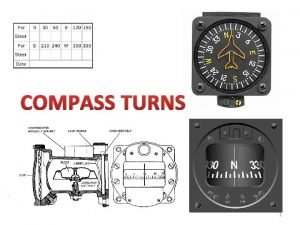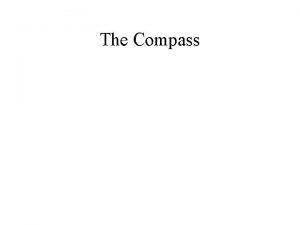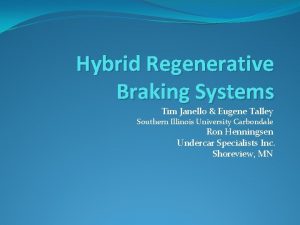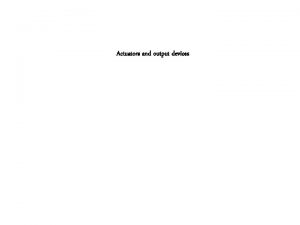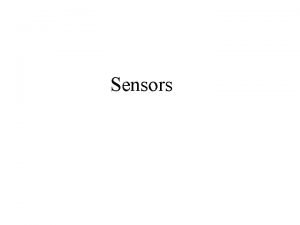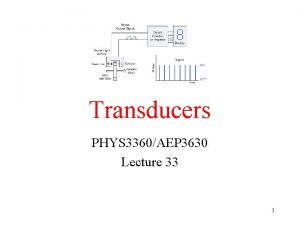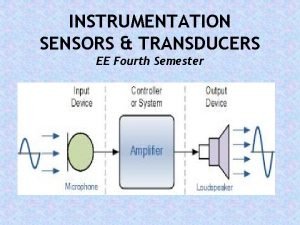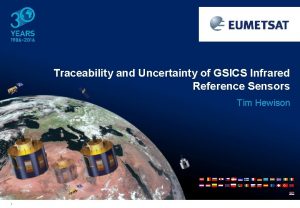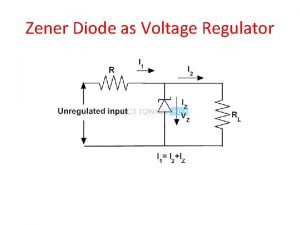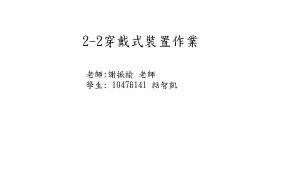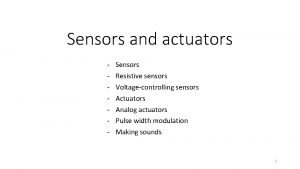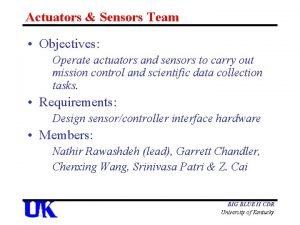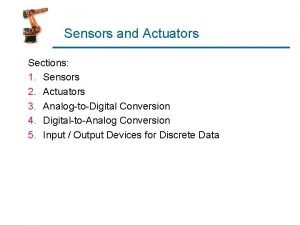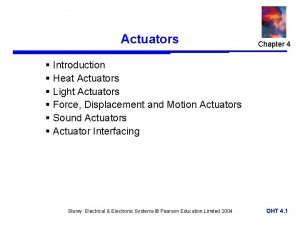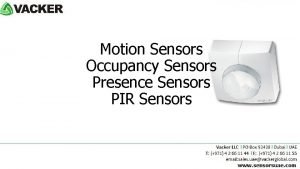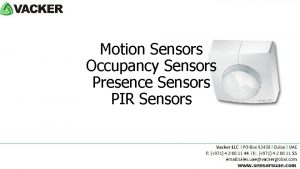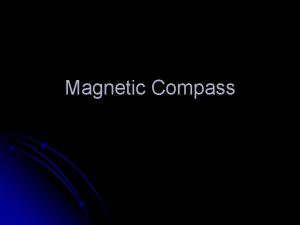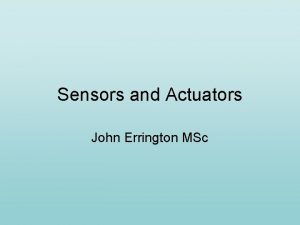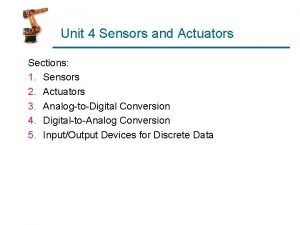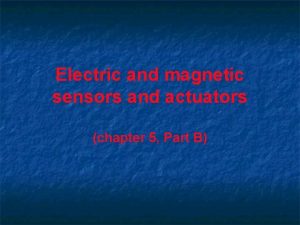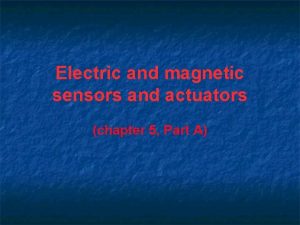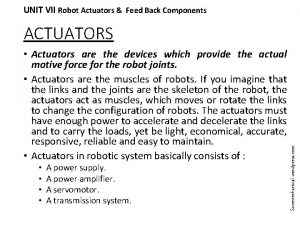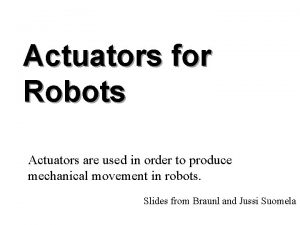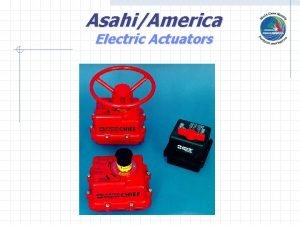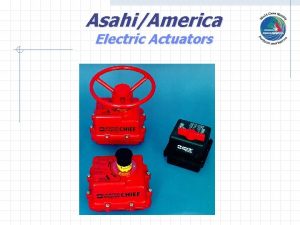Magnetic Sensors and Magnetic Actuators Digital Compass Solution


























- Slides: 26

Magnetic Sensors and Magnetic Actuators Digital Compass Solution Combines a two axis MR Magnetic Sensors in order to detect the magnetic field. Use in wireless phone, vehicle compassing and antenna Positioning. GMR head Structure P. Poulichet February 2005 1

Different types of Magnetic Sensors and Magnetic Actuators Magnetic Sensors • Inductive sensor • Hall sensor • Magnetoresistance (MR) • Giant Magnetoresistance (GMR) • Flux. Gate Magnetic Actuators • Microinductance • Actuators P. Poulichet 2

Units Magnetic Induction: Tesla: T Magnetic Induction: Gauss = 10 -4 T Magnetic field: A. m-1. Magnetic Field Oersted: 1 A. m-1 = 4. pi. 10 -3 Oe Magnetic flux: 1 T. m 2 = 1 wb Permeability: 4. pi. 10 -7 P. Poulichet 3

Characteristics of Magnetic Sensors Measurement Magnetic Field Range (m. T) Sensitivity (n. T) Frequency Range (Hz) Applications Inductive Effect 10 -10 à 106 Depend of applications 0. 1 to 107 Detection of variable Magnetic Field Hall effect 0. 1 à 3. 104 100 0 to 100 M MR And GMR 10 -3 à 5 10 0 to 10 M Ratiometric linear sensor (Current sensor) More sensitive than Hall Effect but less linear (Compasses) « Fluxgate » 10 -4 à 0. 5 0. 1 0 to 10 k P. Poulichet Vectorial Magnetometer (compasses) 4

Inductive Sensors Inductance to generate or to measure a magnetic field Model of the inductor NDE (Non Destructive Evaluation) Electroplating Applications: • NMR (Nuclear Magnetic Resonance) • NDE, Isolator P. Poulichet ADu. M 1100 5

Hall Sensors: Principle Magnetic effect in a long sample l>>w Drift velocity mobility carriers density Current density Magnetic Force The magnetic force push carriers toward the upper edge of the strips. Electricity behaves somewhat like an incompressible fluid. It reacts by developing an electric field, the Hall field that counterbalances exactly 6 the magnetic pressure exactly. P. Poulichet

Hall Sensors The Hall electric field is: The Hall voltage is: Hall angle: Hall coefficient: The Hall voltage depend of: P. Poulichet 7

Hall Sensors: Optimization 1 In order to increase the sensitivity, these materials are use: In. As In. Sb As. Ga n (cm 2/Vs) 33000 78000 8500 p (cm 2/Vs) 460 750 400 Different sorts of errors for Hall sensors: • Scattering of the sensitivity of the Hall voltage • Dependence of the Hall voltage with the temperature • Inductive effect • Offset, linearity P. Poulichet 8

Hall Sensors: Optimization 2 Linearity Offset Inductive effect Magnetic sensor placed near the electronic in order to correct the errors of the Hall Sensor. P. Poulichet 9

Hall Sensors: Applications Reference KSY 14 Siemens Magnetic Field Range (T) offset Voff Sensitivity S m. V. m. T-1 non defined 15 1. 05 à 1. 6 m. V For 1 degree 0. 03% 0. 7% frequency cut-off Price (euros) 1 piece Above 1 6 MHz UGN 3503 Allegro With electronic non defined 2. 5 V 7. 5 à 17. 2 0. 05% pour 0. 05 m. T stable 2% 23 KHz 7 SS 495 A 1 Honeywel l With electronic -0. 06 to 0. 06 2. 5 V 31. 25 3% 0. 04% 1% 50 KHz 7 SS 94 A 2 Honeywel l With electronic -0. 05 to 0. 05 4 V 5 2% 0. 02% 0. 8% 100 KHz 30 P. Poulichet 10

Magnetoresistance: Principle Magnetic effect in a short sample l<<w Lorentz Force Current density As, Jp(B) are present on the two sides of this equation, we can simplified: Jp(0) and B are perpendicular The path of the current in the sample depend of the external magnetic P. Poulichet 11 field. So the resistance depend of the magnetic field.

Magnetoresistance The term show that the resistivity depend of B. Dependence of R/R 0 function of B This type of sensor are not largely use because The characteristics of the magnetoresistance anisotropic are better. In. Sb : Antimoine d’Indium Ni. Sb : Antimoine de Nickel P. Poulichet 12

Magnetoresistance Anisotropic The anisotropy is obtained during the fabrication of the material. It is applied a magnetic that caused a preferred path for the magnetic field. During the step of sputtering on a thin film like Permalloy (Fe. Ni 20% 80%, a magnetic field is applied and this introduce a easy path. This magnetic field introduce a easy axe and a magnetization of the thin Film. M: Magnetization I: Current H: External magnetic field We will show that the resistance depend of the angle and . P. Poulichet 13

AMR In order to simplify, we suppose that H is applied in the direction of Hy. and If I is align with the easy axis: = -. So, • The resistance decrease with the magnetic field. • The magnetic sensor is not linear. • It is also impossible to determine the sign of the magnetic field. P. Poulichet 14

AMR with Barber poles If I is align at 45 degrees: 45 = + P. Poulichet 15

AMR: Realization KMZ 10 A Reference Magnetic field range (T) Sensitivity S: m. V. m. T-1 Supplied with 5 V for 1 degree Bridge Resistance KMZ 10 A Philips -0. 625 m. T to +0. 625 m. T 64 -0. 15 %. °C-1 1. 3 K KMZ 10 C Philips -3. 75 m. T to +3. 75 m. T 6 -0. 15 %. °C-1 1. 7 K P. Poulichet 16

GMR: Principle Sandwich with one ferromagnetic layer and one non magnetic layer. Fe. Cr, Fe. Ni. Ag, Fe. Ni. Cu with thickness Fe = 30 A et Cr = 9 A Without B With B P. Poulichet 17

GMR: Principle Without B With B P. Poulichet 18

GMR Reference Range (T) Offset Voff Sensitivity m. V. m. T-1 supplied with 1 V Linearity Resistance k NVS 5 B 15 1, 5 m 0 4 m. V 30 à 44 2% 5 20% NVS 5 B 50 5 m 0 4 m. V 9 à 13 2% 5 20% NVS 5 B 100 10 m 0 4 m. V 4, 5 à 6, 5 2% 5 20% P. Poulichet Realization (NVE) 19

Applications of AMR and GMR Measurement of current Detection of the speed Sensitivity Size Resolution Anisotropic Magnetoresistance (AMR) Giant Magnetoresistance (GMR) 0. 5%/Oe 1 -100 µm 0. 1 Oe 1%/Oe 1 -100 µm 0. 01 Oe Wire Fe. Co. Ni electroplated (GMI) 500%/Oe 1 -2 mm P. Poulichet 0. 000001 Oe 20

Flux. Gate: Principle The first winding is used to saturate the magnetic Material. When the magnetic material is saturate, there is no voltage across the second winding. Measurement of delay introduce on the voltage across the second winding will be help to determine the value of the magnetic filed. When there is no magnetic field, the gap between the pulse is constant. When a magnetic field is applied, the gap between the two pulses are different. P. Poulichet 21

Flux. Gate: Realization Configuration of the windings The fluxgate is very sensitive. The realization is complex but magnetic sensors with low sensitivity have good perspective. P. Poulichet 22

Magneto Impedance: MI Principle: Use the skin effect A current in a wire cause that the current density is concentrate at the periphery of the wire. So the impedance of the wire increase with the frequency. A external magnetic field cause also a dependence of the impedance with the magnetic field. The purpose is to polarize the wire at a frequency and the external magnetic field cause a variation of the impedance. Characteristics Polarization at 10 MHz. Range of B from n. T to µT. Sandwich of Layers: Fe. Co. Si. B: 40 µm thickness. Wire: Co. Fe: 30 µm diameter. P. Poulichet 23

Magnetic Actuator MAGMAS: Magnetic micro actuator and system A micro Inductance is used to generate a magnetic field. This magnetic field act on a magnetic layer in order to develop a force. Micro Inductance Conductor (Al, Cu) deposed on a substrate glass or Si. The size, the number of turns give a inductance value. The thickness of the conductor must be important. The conductor need to be deposed by electroplating in a molding. Current density increase with the reduction of the size of the conductor (1000 A. mm-2 for a wire with a µm dimension). Magnetic material Permalloy Fe. Ni electroplated. Magnet The magnet is placed under the micro inductance. It is glued or electroplated. P. Poulichet 24

2 D Optical Switch Array for Optical Routing A mirror move when a current is applied on the micro inductance. It reflect the light transmit with the optics fiber. Under the membrane, the permalloy is electroplated. Under the coil, a magnet is placed. A pulse in the coil shift the mirror. When the signal is interrupted, the mirror stay in position. When another pulse is applied on the coil, the mirror move. P. Poulichet 25

Bibliographie About Hall Sensors: Hall Effect Devices RS POPOVICS (Library). About GMR: Magnetic Multilayers and Giant Magneto-resistance, Springer, Surface Sciences (Library). P. Poulichet 26
 Elements of mechatronics system ppt
Elements of mechatronics system ppt Sensors and actuators introduction
Sensors and actuators introduction Ie 423
Ie 423 Peas model
Peas model Local attraction in compass surveying
Local attraction in compass surveying Can dead man vote twice
Can dead man vote twice Effectors and actuators
Effectors and actuators Advantages and disadvantages of hydraulic actuators
Advantages and disadvantages of hydraulic actuators Gyrocompass
Gyrocompass Compass errors
Compass errors Uses of compas
Uses of compas What is principle of compass surveying
What is principle of compass surveying Blocked pitot tube
Blocked pitot tube Stroke simulator prius
Stroke simulator prius Is an actuator an input or output device
Is an actuator an input or output device Magnetic retentivity
Magnetic retentivity Magnetic flux density units
Magnetic flux density units Magnetic moment and magnetic field relation
Magnetic moment and magnetic field relation Force on a charged particle
Force on a charged particle Sensors and transducers are subsystem of mechatronics.
Sensors and transducers are subsystem of mechatronics. Ajay sensors and instruments
Ajay sensors and instruments Transducers and sensors
Transducers and sensors Transducer
Transducer Sensors and traceability
Sensors and traceability Vapour pressure composition curve for non ideal solution
Vapour pressure composition curve for non ideal solution Static characteristics of sensors
Static characteristics of sensors Wearable inertial sensors
Wearable inertial sensors

